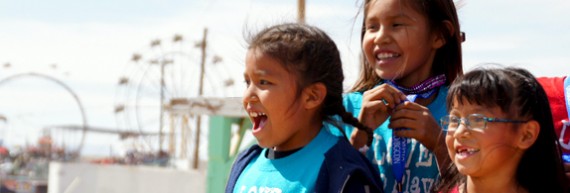UNM professor Jessica Goodkind believes that community-based projects within Native American communities will help prevent mental health and substance abuse problems among Native American youth populations.
According to the American Psychiatric Association, American Indians and Alaska Natives experience serious psychological problems 1.5 times more than the general population.
The Substance Abuse and Mental Health Services Administration (SAMHSA) reported that in 2011, substance abuse or dependency affected almost 17% of Native American and Alaska Native populations aged 12 or older. In a similar SAMHSA survey, about 8.7% of the general population in the United States above the age of 12 reported substance abuse or dependency.
Goodkind believes that these issues are tied to historical trauma and disconnect between Native American youth and their Native American cultures. She said that in looking at Native American history, we can understand how Native Americans have struggled to keep their culture alive and overcome social and economic obstacles.
“…It’s not just thinking about what’s wrong with that individual, but what’s wrong with their family context, the community context, the social structures that affect them, the historical context,” she said. “So for Native Americans, it’s thinking about the history of colonialism, oppression and genocide.”
Goodkind said that poverty also creates a gap between Native American youth and their culture, and impacts the likelihood of mental health and substance abuse problems.
According to the 2012 United States Census, the median income of American Indian and Alaska Native household was about $35,000, compared to the national average of about $50,500 per year. According to the 2010 United States Census, about 28% of American Indian and Alaska Natives lived in poverty, whereas the national average was about 15%.
Goodkind said that living with fewer resources and in less stable conditions influences the choices Native American youth will make in the future.
“I think a lot about prevention,” Goodkind said. “How do we sort of build on the cultural and community strengths to prevent that and prevent these cycles where kids are coming from really disrupted homes and fewer community resources?”
In order to promote healing within Native American communities and help Native American youth reconnect with their culture, Goodkind works with community youth and elders to establish curriculums that teach substance abuse prevention as well as Native American culture and beliefs.
Goodkind said that one project, Project TRUST, aims to understand challenges to providing behavioral healthcare to Native American youth. She said often times Native American youth have trouble trusting those who try to help.
“We identified trust is a really key issue,” she said. “They don’t really trust people who are offering help to them because often there is the adult/youth divide, and often, depending on who the providers are, if they are non-native, they might not understand as much about the perspective of youth.”
According to Goodkind, school-based programs can also help prevent future substance abuse and mental health problems. She said that teaching Native American youth about their culture helps tie them to something meaningful.
Goodkind helped develop a curriculum for a family-based program to help youth better understand their culture and teach parents how to support their children. The curriculum is taught from a book called Our Life, which teaches traditional Navajo culture and practices and substance abuse prevention while providing parents with information to help strengthen parenting skills.
“One of the problems is a lot of the youth programs only involve the youth, but we feel that it is really important to involve the family because that’s the way you are able to create change,” she said. “There are parent strengthening components to help parents develop all of the things that help prevent these problems – setting boundaries, providing love and support, knowing what’s going on in your kids life and improving communication between parents and kids.”
Goodkind said she helped develop Working to Restore Balance and Harmony: Community Place Mapping Project, a book that teaches Navajo youth about historically and culturally important places in the Navajo community. She said the book contains a map of all fifty important places, and is written in both Navajo and English.
“The Navajo community identified the land as something that was really healing to them and really important and sort of how they coped when they were stressed was to go out and be with the land,” she said. “So the elders gave narratives of and talked about the significance of each place and the youth and elders went together and took photographs of each place.”
Goodkind said the most fascinating part of the project was that the youth and their elders worked together to create the map.
“Part of the issue is the break between youth and elders,” she said. “And the language is a problem because they may not have a common language.”
Goodkind said an important aspect of prevention is to promote healing, and that a long history of cultural and social displacement plays a major role in mental health and substance abuse problems. She said it is also important for non-natives to understand that Native American communities have a very traumatic history, which needs to be addressed in order to help Native American people heal.
“Traditional culture is there, and it’s strong,” she said. “But the United States government has never really offered a meaningful acknowledgement and apology and reparations for what has been done, and I think that’s a huge part of healing for people too. That if those past injustices and traumas are not acknowledged it’s really hard to move past them.”
(Feature image by Navajo Nation Washington)




Responses to “Native Healing: A community-based approach”